
- Advanced Excel Tutorial
- Advanced Excel - Home
- Excel New Features
- Excel - Chart Recommendations
- Advanced Excel - Format Charts
- Advanced Excel - Chart Design
- Advanced Excel - Richer Data Labels
- Advanced Excel - Leader Lines
- Advanced Excel - New Functions
- Fundamental Data Analysis
- Excel - Instant Data Analysis
- Excel - Sorting Data by Color
- Advanced Excel - Slicers
- Advanced Excel - Flash Fill
- Powerful Data Analysis
- Excel - PivotTable Recommendations
- Powerful Data Analysis – 1
- Advanced Excel - Data Model
- Advanced Excel - Power Pivot
- Excel - External Data Connection
- Advanced Excel - Pivot Table Tools
- Powerful Data Analysis – 2
- Advanced Excel - Power View
- Advanced Excel - Visualizations
- Advanced Excel - Pie Charts
- Advanced Excel - Additional Features
- Advanced Excel - Power View Services
- Advanced Excel - Format Reports
- Advanced Excel - Handling Integers
- Other Features
- Advanced Excel - Templates
- Advanced Excel - Inquire
- Advanced Excel - Workbook Analysis
- Advanced Excel - Manage Passwords
- Advanced Excel - File Formats
- Excel - Discontinued Features
- Advanced Excel Useful Resources
- Advanced Excel - Quick Guide
- Advanced Excel - Useful Resources
- Advanced Excel - Discussion
Advanced Excel - Additional Features
Power View in Excel 2013 provides an interactive data exploration, visualization, and presentation experience for all skill levels as you have seen in the previous section. You can pull your data together in Tables, Matrices, Maps, and a variety of Charts in an Interactive View that brings your Data to life. New features have been added to Power View in Excel 2013.
You can also publish Excel workbooks with Power View sheets to Power BI. Power BI saves the Power View sheets in your workbook as a Power BI report.
Power View sheets can connect to different data models in one workbook.
In Excel 2013, a workbook can contain −
An internal Data Model that you can modify in Excel, in Power Pivot, and even in a Power View sheet in Excel.
Only one internal Data Model, and you can base a Power View sheet on the Data Model in that workbook or on an external data source.
Multiple Power View sheets, and each of the sheets can be based on a different data model.
Each Power View sheet has its own Charts, Tables, and other Visualizations. You can copy and paste a chart or other visualization from one sheet to another, but only if both sheets are based on the same Data Model.
Modify the internal Data Model
You can create Power View sheets and an internal Data Model in an Excel 2013 workbook. If you base your Power View sheet on the internal Data Model, you can make some changes to the Data Model while you are in the Power View sheet itself.
Step 1 − Select the worksheet Salesperson.
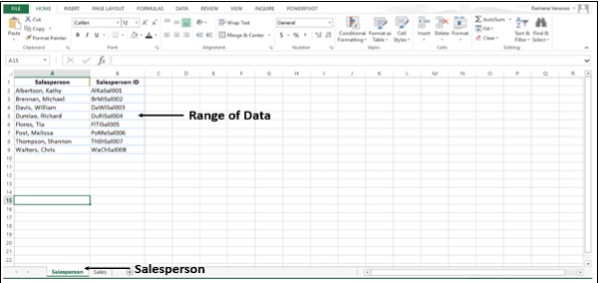
You have a Range of Data of Salesperson and Salesperson ID.
Step 2 − Now select the Worksheet Sales. You have a Range of Data of Sales.
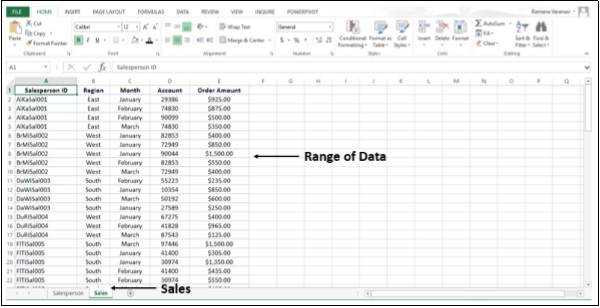
Step 3 − Convert the data in the worksheet Salesperson to table and name it Salesperson.
Step 4 − Convert the data on the Sales Worksheet to table and name it Sales. Now, you have two tables in two Worksheets in the Workbook.
Step 5 − Click on the Sales Worksheet.
Step 6 − Click on the INSERT tab on the ribbon.
Step 7 − Click on Power View.
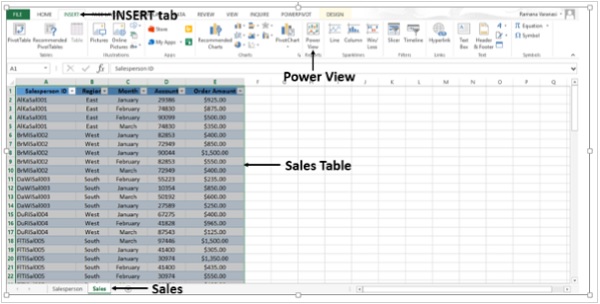
Power View sheet is created in the Workbook. In the Power View Fields list, you can find both the tables that are available in the Workbook. However, in the Power View, only the Active Table (Sales) Fields are displayed since only the active Data Table Fields are selected in the Fields List.
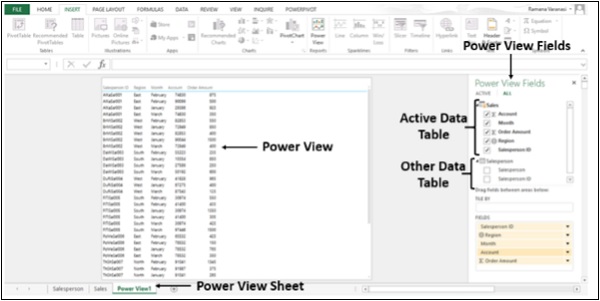
In the Power View, Salesperson ID is displayed. Suppose, instead you want to display the names of the salespersons.
Step 8 − De-select the Field Salesperson ID in Power View Fields.
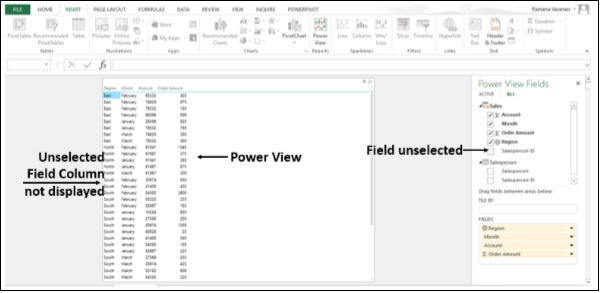
Step 9 − Select the Field Salesperson in the Table Salesperson in Power View Fields.
You do not have a Data Model in the Workbook and hence no relationship exists between the two tables. Excel does not display any Data and displays messages directing you what to do.
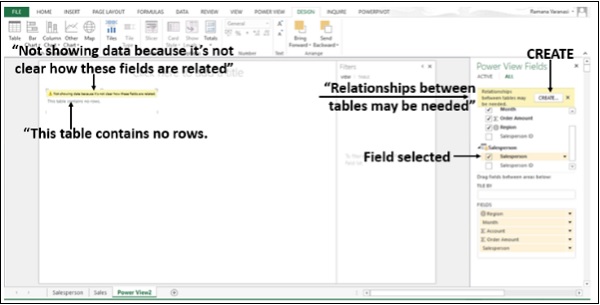
Step 10 − Click on the CREATE button. The Create Relationship Dialog Box opens in the Power View sheet itself.
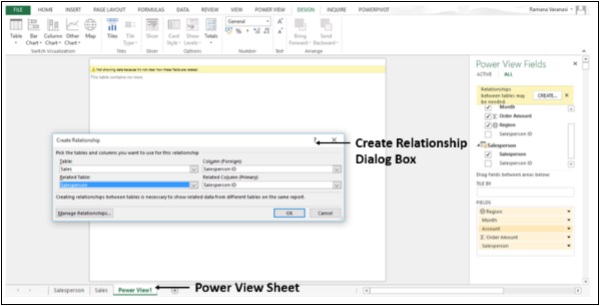
Step 11 − Create the relationship between the two tables using the Salesperson ID Field.
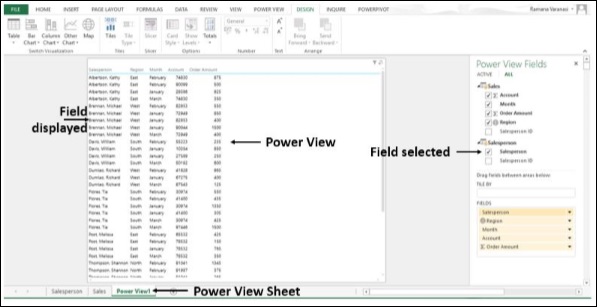
You have successfully created the internal Data Model without leaving the Power View sheet.